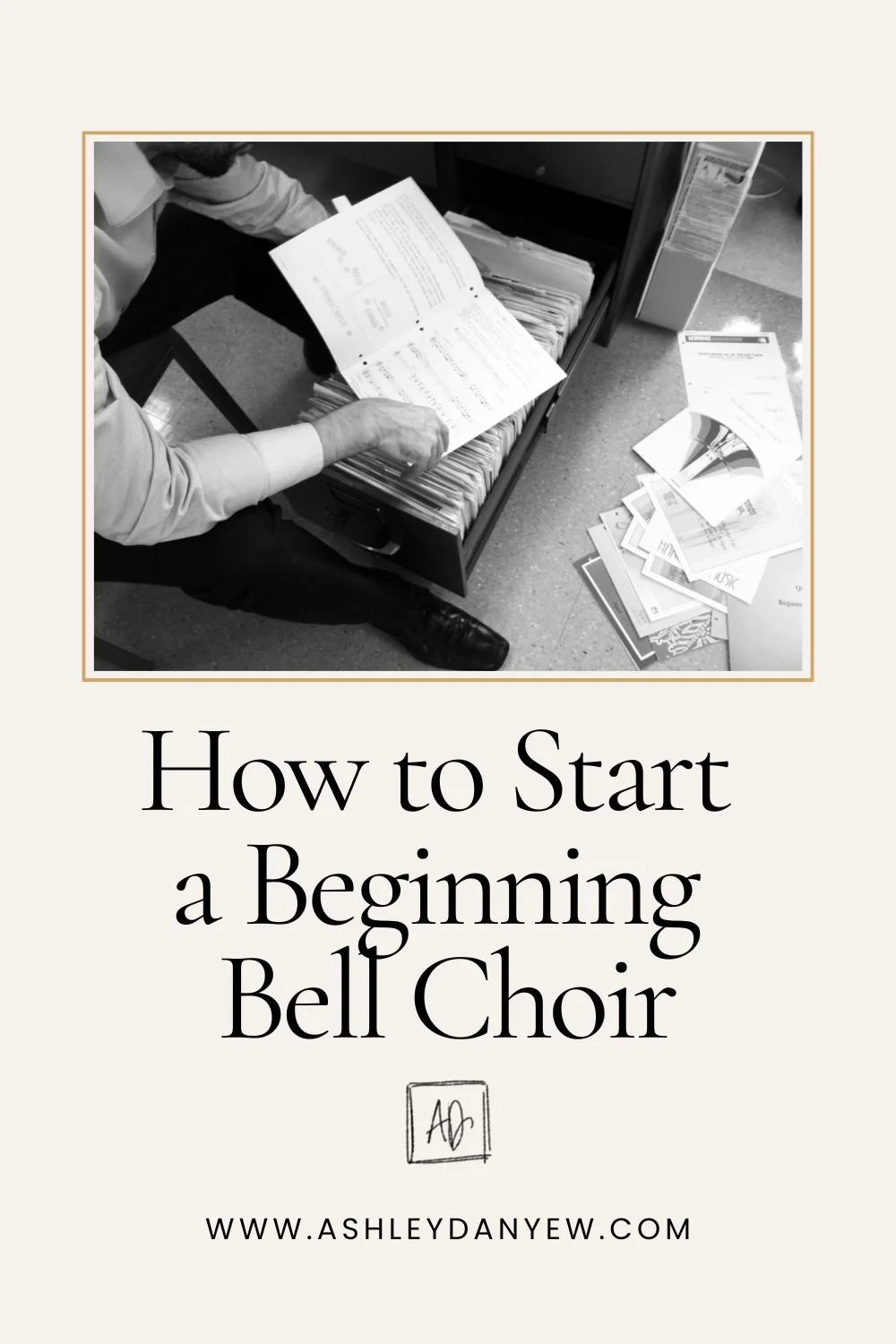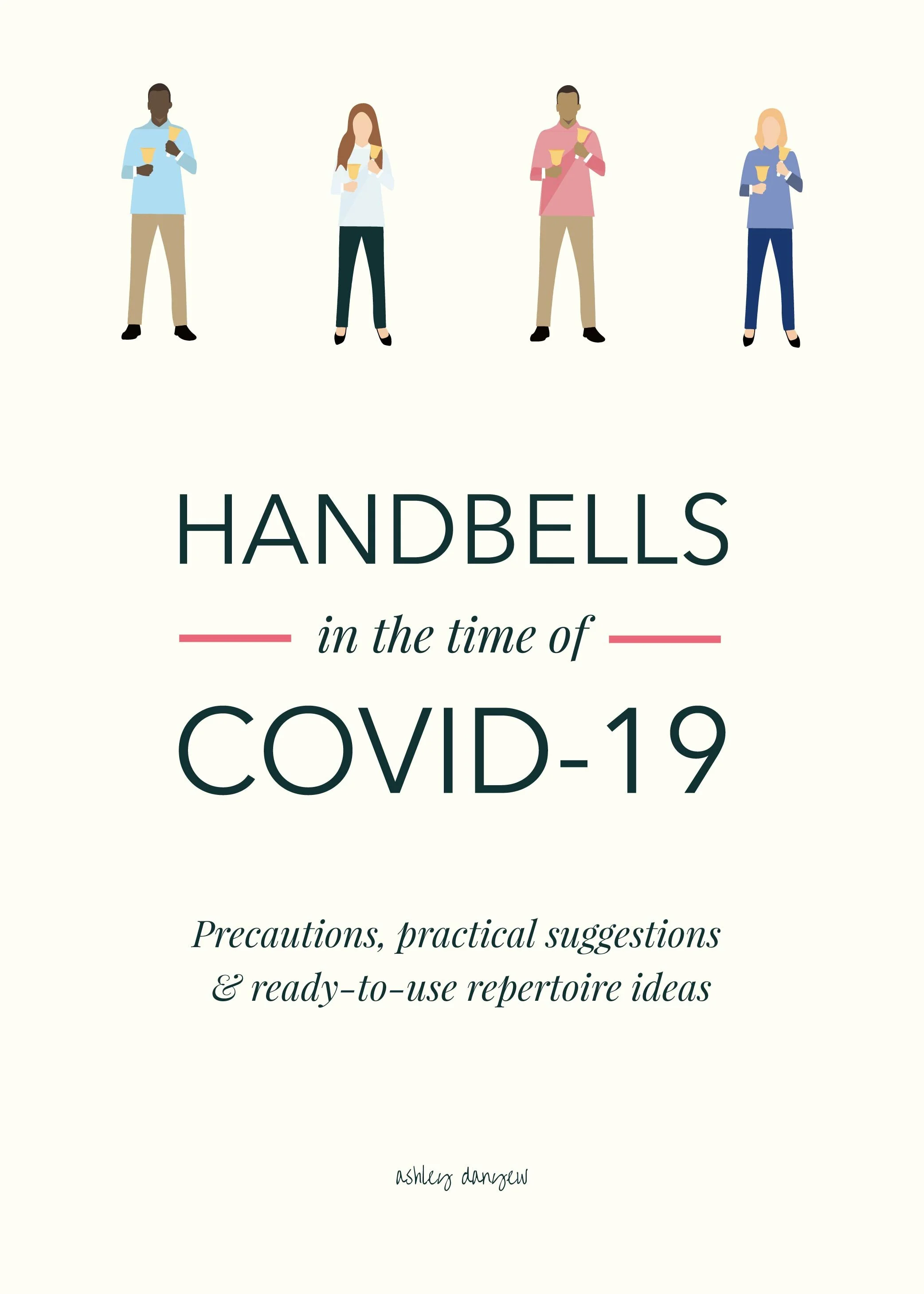So, you want to start a handbell choir.
The only problem is, you don't know the first thing about ringing and your ringers are mostly newbies without a whole lot of previous musical experience.
What's a want-to-be handbell choir director to do?
The good news is you don't need to have a lot of experience or professional training to lead and direct a handbell choir (though, that never hurts).
With a desire to learn, a solid sense of rhythm and steady beat, and a little practical know-how, you'll be on your way to building and leading a handbell choir in no time.
Today, I'm going to walk you through the step-by-step process of starting and directing a handbell choir with little (or zero) experience.
Ready to get started?
A Step-By-Step Guide to Starting a Bell Choir
*Disclosure: I get commissions for purchases made through links in this post.
Getting Organized
Let's begin by talking about the necessary equipment and supplies. Handbell choirs require a few special things that you don't see with other ensembles.
What you'll need:
set of handbells (2 octaves minimum)
notebooks (not just any notebooks...)
Once you have all the necessary equipment and supplies, it's time to begin recruiting.
Who will play in your group? Adults, youth, older children, mixed ages? If you're interested in creating an intergenerational group, I'd recommend inviting 3rd graders and up.
Plan for one rehearsal a week—that’s how most churches do it. An hour would be great if you could swing it, but 45 minutes works just fine.
Setting Up + Learning How to Ring
Begin by setting up the bells on the padded table in keyboard order, lowest to highest, and like a piano, with white keys toward the front edge of the table and black keys further back.
Note: Handbells sound one octave higher than written. Therefore, C5 is Middle C (unlike the piano, where Middle C is C4).
Assign each person two white-key bells, to start. For beginning music, you probably won’t really use the black-key bells (especially if you’re playing in C major) and if you do, it will probably be only 1-2 black-key bells (and they would be in place of the white-key bells).
Demonstrate holding the bell, ringing in a circular motion, and damping on the shoulder. Give your ringers a few seconds to try this.
For a quick tutorial on setting up the bells, preparing to play, and how to teach basic ringing techniques, take a look at this helpful (free!) video series:
*This is the basic sequence I tend to start with for new ringers to get them used to the feeling of ringing and damping.
Once you’ve gone over the basics of holding the bell, ringing, and damping, you might try a brief improvisation or rhythm activity. This is a great way to get everyone ringing and doing something musical right away, even if they don’t read music.
Related post: Improvisation Activities for Handbells
Teaching by Rote
Does everyone in your group read music? If so, then you can jump right into playing from notation. If not, I’d recommend doing some things by rote in the beginning (use rhythm cards and bell letter names to help people keep track of their part).
Much of what’s involved in teaching handbells comes back to rhythm, so do whatever you can to help your players develop rhythmic reading skills and a strong, internal sense of steady beat. This will set you (and your ringers!) up for success down the road.
Consider starting with song charts made with a Post-It Note flip chart or poster board (or make individual copies for everyone to have in a notebook in front of them). Write out just the rhythmic notation with letter names underneath (no staff lines). If possible, indicate the direction of the melodic line on the chart, instead of writing it out in straight rows.
Pro Tip: When you’re just starting out, you might try using a color-coding system to help new ringers learn to read and follow along in the music (this is especially helpful with younger ringers). You could even try color-coding the bells themselves in the beginning by placing small sticker dots on the handles (C = red, D = orange, E = yellow, etc.).
Processionals and acclamations are usually fairly simple to pick up and learn without notation. Here are a few to consider:
Four Easy Handbell Processionals (arr. Michael Burkhardt) - 3 octaves
Processionals for Handbells (John Behnke) - 3-5 octaves
Three Processionals for Handbells and Chimes (Downey) - 3-5 octaves
Well-Tempered Handbell Processionals (arr. Charles E. Peery) - 2-3 octaves or 4-5 octaves
Six Processionals (Sandra Eithun) - 3-5 octaves
Four Pieces for Advent (Ashley Danyew) - 2 octaves (12 bells)
Four Pieces for Lent (Ashley Danyew) - 2-3 octaves (12-19 bells)
Five Processionals (Ashley Danyew) - 3-5 octaves (11-12 bells)
Free Resource
An easy-to-learn introit for ringers of all ages.
A short, festive acclamation or introit for 16 bells. Perfect for your beginning bell choir (the piece is built on simple, repeated rhythmic patterns—no music required!). Works well as a processional (if your group can ring and walk at the same time!).
Introducing Music-Reading
Once your ringers get the hang of reading rhythmic notation and playing their own part, introduce them to staff notation and point out which line and space match the bells they’re holding. Encourage your ringers to use highlighters to color-code their music before they play (e.g. blue = left-hand bell, red = right-hand bell).
Here’s a fun (online) note-naming game you can play as a group to continue developing their reading skills.
As for other note-reading resources, here are a few you might consider:
The Hal Leonard Handbell Method
A comprehensive guide to learning to play handbells (or handchimes), including beginning technique, music-reading, and music for practice and performance
Basic Training for Bells and Basic Training 2: Rhythm Training for Ringers (Venita MacGorman)
An invaluable resource for new ringers (and directors!), this curriculum includes rote exercises, hymn and classical transcriptions, and lessons in essential playing technique.
Sing ’n’ Ring (Michael Burkhardt)
A reproducible collection featuring chordal warm-ups and accompaniments
Learning to Ring: Favorite Hymns and Standard Hymns (Janet Van Valey)
Two large collections of hymn tunes arranged specifically for new ringers (2 octaves)
E-Z Reader Songs of Praise and Spirituals (Susan Berry & Janet Van Valey)
Simple settings of sacred hymns, songs, and spirituals designed for beginning choirs (2 octaves)
5 Hymns for Beginning Ringers (Anna Laura Page)
Hymn settings expertly arranged to serve as teaching pieces for new ringers
Keep It Simple 1, 2, 3, and 4 (Lloyd Larson)
Accessible hymn arrangements for the beginning handbell choir
Teaching Handbell Notation & Special Techniques
If you’re looking at a piece of handbell music, you might notice many different signs and symbols we don’t see in other types of music. Welcome to the world of handbell notation.
Here’s a helpful guide to handbell notation and what each sign/symbol means.
And in case you're wondering what these techniques look/sound like, here are a few helpful video demonstrations so you know how to demonstrate them for your choir: Part I and Part II. Just so you know, some of these techniques are more advanced than others, and you may not see them in a piece of music until Level 3, or so.
Using Bells in Worship
Finally, think about ways to incorporate handbells in your worship service. I tend to take a more creative approach to this than some—I think handbells can be used in many more ways than just playing a prepared piece as the prelude or offertory. Here are some helpful books and resources to help get you started:
The Creative Use of Handbells in Worship, Book 1 (Hal Hopson)
Ranging from ideas for one handbell to suggestions for a full handbell choir
The Creative Use of Handbells in Worship, Book 2 (Hal Hopson)
Easy settings for a few (4-6) ringers
10 Creative Ways to Use Handbells in Worship
Ideas for introits, responses, transitions, and underscoring
Handbells in the Catholic Liturgy (Jeffrey Honore)
Acclamations, intoning psalmody, and contemporary songs in a variety of styles
Hymtroits - Handbell Score (Kevin McBeth)
Featuring simple ostinato pattern accompaniments playable by four ringers
Related post: 10 Creative Ways to Use Handbells in Worship
Closing
And there you have it! A step-by-step guide to starting a handbell choir. I hope this is helpful. Have questions? Ask away in the comments—I'd be happy to answer them!
Feel like a newbie when it comes to leading and directing a handbell choir?
You’re not alone.
In fact, that’s why I created Music Education & Leadership Skills for the Handbell Choir Director, a mini online training course just for handbell choir directors.
This course will help you develop valuable teaching skills and equip you with the practical tools and skills you need to lead and teach your handbell choir with creativity and confidence. I’d love to have you join me!






















![Handbell Notation Guide [Infographic]](https://images.squarespace-cdn.com/content/v1/585c710603596e2c47dad93e/1491403915874-P2UH6FM8J1W1HM4UWP17/Handbell+Notation+Guide-02.png)


![The Joy of Children's Handbell Choirs [Video]](https://images.squarespace-cdn.com/content/v1/585c710603596e2c47dad93e/1482458472572-UQOTZ604Q6UKSIBZVYEZ/image-asset.png)










